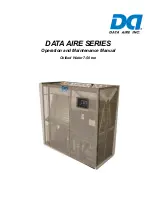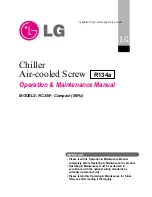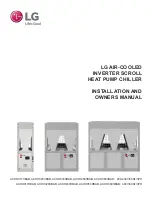
Flue equipment procedure
Select a flue material having sufficient corrosion resistance. Provide the flue with heat insulation to
prevent burns and ambient temperature rises.
Design a flue that makes the static pressure 0 Pa to -49 Pa at the high-temperature generator
connection to the flue. Install two or more flues, a draft regulator for stabilizing combustion, and a
fixed damper for adjusting ventilation force. If more than one chiller-heater is installed or a chiller-
heater is installed side by side with a boiler, and so on, provide the chillers with separate flues to
prevent the back flow of exhaust gas to the machine that is not operating.
When installing an assembly gas duct unavoidably, design one that makes the exhaust gas
pressure 0 Pa to -49 Pa at each machine connection with the flue. In addition, connect the flue
junctions at an angle of 45°F, or less or install a rectifier plate to prevent the mutual interference
of exhaust gas from the individual flues, see Figure 20. The flue must be free of sharp bends or a
sharp change in passage area. Make the bends gentle and install a guide plate as required.
When the chiller-heater is installed side by side with a machine that has a different combustion
system (for example a diesel engine), provide the chiller-heaters with separate flues to ensure
stable combustion and prevent oscillating combustion.
When a flue damper is installed, provide the damper with a limit switch for confirming “full open”
of the damper in order to prevent explosions. In addition, secure the interlock that prevents the
chiller-heater from being started with the damper kept closed (see the procedural drawing for
sequential operation).
The flues should be as short as possible. In particular, the horizontal flue led from the chiller-heater
outlet must be as short as possible in order to prevent a decline in ventilation force, preferably,
within 1 m from the machine base. In this case, make the flue rise 2 m or more and then secure it in
the horizontal position. If the horizontal section of the flue is too long, it can cause unstable and/or
oscillating combustion.
Install the following devices to the flue:
• Mount for thermometer that measures flue gas temperature
• Drain port
• Seat for measuring draft pressure
• Combustion chamber inspection window
• Combustion monitor
At the points where the flue and smokestack penetrate a wall or ceiling, use a heat-resisting, fire-
proof construction (nonflammable material, such as concrete.
Provide the flue with sufficient support taking its thermal expansion into account. In addition,
provide the flue with a suitable vibration-proof measure. Make sure that the flue does not apply
load to the chiller-heater.
If there is noise concern, consider installing a flue muffler or a smokestack.
Keep the flue openings significantly away from the air inlets of the cooling tower and air
conditioner so that the flue gas does not enter cooling tower, and so on. In particular, when the
chiller-heater uses a fuel containing a considerable amount of sulfur (for example, kerosene oil
or a heavy oil), install a protective shield or prevent installation of the chiller-heater and other
equipment in the same section enclosed by walls. Make the flue free from entry of rainwater, snow,
and so on. In addition, the flue must be constructed so that the ventilation is not prevented by
winds, and so on.
35
Model YHAU-CGN/H-CXR(M)Double Effect Direct Fired Small Absorption Chiller-Heater
















































